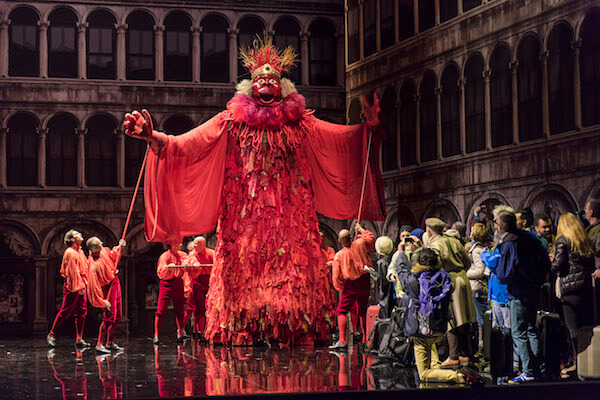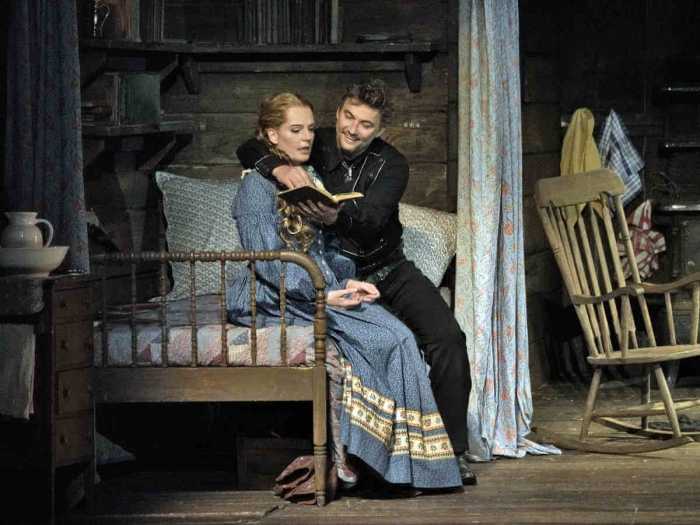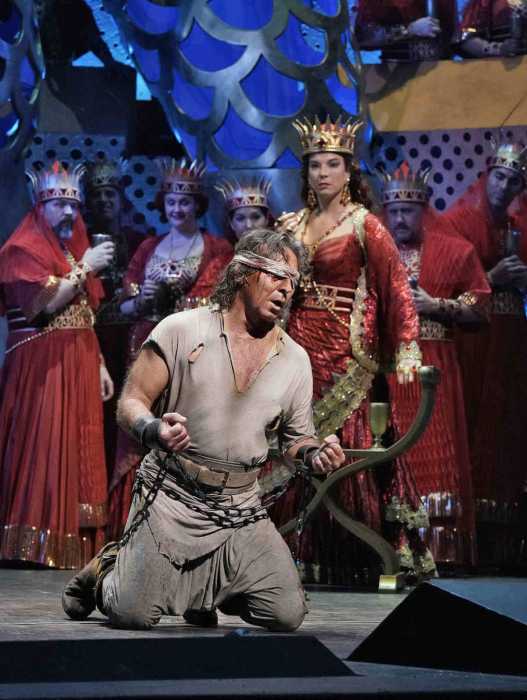William Christie and Les Arts Florissants brought André Campra’s “Les Fêtes Vénitiennes” to BAM last month. | JACK VARTOOGIAN/ BAM
In recent months opera companies (large and small) and touring ensembles have been exploring the vicissitudes of love won and love lost as viewed through an often cynical 18th century Enlightenment sensibility warmed by the kindling fires of nascent Romanticism.
The Metropolitan Opera presented a rare revival of Mozart’s “Die Entführung aus dem Serail” with James Levine leading a group of fresh new singers. In Mozart’s 1782 singspiel, the Turkish pasha gives the Europeans a lesson in enlightened values and humanity.
Levine conducted his last staged opera as the Met’s music director before assuming emeritus status next season. Perhaps it was the youth of his soloists combined with the weight of responsibility taken off of his shoulders, but on May 3 Levine conducted like a rejuvenated man. His left arm no longer flapped about but adroitly cued the ensemble. Tempos bounced with animation and then turned slow and somber on a dime, as Mozart dictates. The cast, serious and studious in intent, were not individually the most polished Mozart stylists but worked effectively as an ensemble under the maestro’s lead.
A Met rare Mozart revival, Les Arts Florissants brings Campra to BAM
Tashkent-born Albina Shagimuratova did not shy from the rigorous coloratura demands of Konstanze, but her tone turned metallic with a glassy pitch-obscuring glare in exposed high music — which constitutes the majority of the vocal writing. “Ach ich liebte” suffered from barely indicated trills, while “Martern aller Arten” had good attack on high register scale work but a weak-toned lower register. In more central-lying lyrical music such as the duet with Belmonte, Shagimuratova’s tone lost the over-bright edge, gaining purity and elegance.
Paul Appleby as her rescuer Belmonte displayed firm musicianship and accurately sung German diction, but his lyric tenor lacked float and fluency — the runs in “Ich baue ganz” were labored. German basso profundo Hans-Peter König as the sinister harem keeper Osmin reveled in his low notes and droll deadpan menace. His Wagnerian bass also lacked Mozartean bel canto fluency approximating the coloratura demands. König made up for it in vocal and theatrical presence, delightfully playing off his enormous height and girth against the tiny sparkplug Blondchen of Kathleen Kim. She daintily scaled the high E’s in Blondchen’s aria yet her tone was buttery and sweet lower down. She won over the audience and her Pedrillo, tenor debutant Brenton Ryan. As slim and agile as a ballet dancer, Ryan expertly balanced singing, speaking, and comic stage pratfalls with natural flair.
Actor Matthias von Stegmann was an effete, sexually unthreatening Pasha Selim. This anodyne quality and lack of darker undertones typifies the tired 1979 John Dexter/ Jocelyn Herbert production, which looked like a flimsy, vaguely camp children’s pop-up book. Stephen Pickover’s revival direction gave the singers a lot of business but very little meaningful interaction. The 18th century, like today, was a time when Arabic cultures were invading Europe, inspiring revulsion, fear, and fascination in Western eyes. A fresher look is needed for today’s audience.
In April, William Christie and Les Arts Florissants returned to the Brooklyn Academy of Music with the opéra-ballet “Les Fêtes Vénitiennes” by André Campra. LAF co-presented the piece with the Opéra-Comique in a production staged by Robert Carsen. The choreography by Ed Wubbe featured members of his Scapino Ballet Rotterdam.
“Les Fêtes Vénitiennes” was one of the most popular pieces in the 18th century Paris repertory — after its 1710 premiere it totaled more than 300 performances in multiple revivals over the next 50 years. Christie has educated New York music lovers on many aspects of the French baroque — the tragédie lyrique of Lully and Charpentier in particular — but this was his first excursion into the opéra-ballet genre. Commercially popular and less courtly in tone, the opéra-ballet anticipated the modern revue — short entrées or comic vignettes on themes of disguise and seduction feature short vocal solos and ensembles and large-scale dance sequences. There is an emphasis on spectacle with special effects and scene changes.
The three vignettes depict amorous intrigues taking place during the Venice carnival where Reason in the prologue gives way to Folly. First entrée: at a costume ball Prince Alamir disguises himself as his valet to test the love of the innocent Iphise, who proves she loves him for himself not his rank. In the second scene a pair of jealous rival beauties stalk the two-timing Léandre and catch him serenading a third woman — who rejects him as do his two former conquests. In the last vignette, the pretty opera singer impersonating Flora is pursued by three suitors. She is delighted when the one she loves takes the place of a singer impersonating the wind god Boreas in the opera and abducts her for real. In the final scene, the carnival ends and normalcy is restored — or so we hope!
Campra composed light, hummable ditties similar to popular songs for the leads, with comic duets and trios that prefigure operetta. The dance numbers are raucous and up-tempo, with an emphasis on percussion.
As is typical of Les Arts Florissants, the musical elements were historically informed and period practice whereas the physical production was updated, inventive, and sophisticated. The shifting walls designed by Radu Boruzescu took us instantly from the moonlit streets and canals of night time Venice to glittering gold-painted palace interiors. Petra Reinhardt’s costumes, like the choreography and production, were an insouciant mix of period style with hip contemporary touches.
In the prologue, Carsen has the dancers and chorus impersonating modern tourists in Venice (complete with iPhone cameras and backpacks) who are drawn by the giant puppet figure of Folly into the magical world of the 18th century. Carsen integrates the singing chorus and dancers who move in and out of the action as one. Ed Wubbe’s choreography is more vernacular than classical — there is cross-dressing, brief nudity, twerking, and butt-slapping, with an emphasis on decadent fun.
The majority of the youthful singers were graduates of Christie’s vocal ensemble Jardin des Voix, a baroque training program. Of them, only the lovely Rachel Redmond in three roles (including Flora) emerged as a distinctive, major vocal presence. The familiar veteran haute-contre tenor Cyril Auvity stood out for his experienced command of French baroque style.
Campra’s score for “Les Fêtes Vénitiennes” is not musically on the level of his tragédie en musique “Idomenée” — it is aiming at a less rarified clientele. (The libretto of “Idomenée” was adapted for Mozart’s “Idomeneo,” to be revived at the Met next year under Levine). But the presentation by Les Arts Florissants at BAM transported us into an unfamiliar dream-like baroque landscape much like those modern day tourists in the prologue of Carsen’s production.
MasterVoices is the successor company to what was formerly the late Robert Bass’ Collegiate Chorale. The new artistic director is Juilliard-trained Ted Sperling, a versatile conductor, orchestrator, stage director, and musical arranger with one foot on Broadway and the other in classical music.
The company’s annual City Center season has been exploring a theme of classical crossover – last October it presented diva Deborah Voigt flanked by Broadway performers in Gilbert and Sullivan’s “The Pirates of Penzance.”
In late April, MasterVoices presented two semi-staged performances of Purcell’s “Dido and Aeneas.” Doug Varone directed and choreographed and his dancers performed the modern dance interludes.
Sperling won a Tony Award for his orchestrations for Adam Guettel’s “Light in the Piazza,” which he also conducted for Lincoln Center Theater a decade ago. This “Dido” concert reunited Sperling with his two leading ladies from that show – Kelli O’Hara and Victoria Clark, both of whose Tony-winning Broadway careers were launched with it. All three were classically trained: O’Hara as a lyric-coloratura in the opera program at Oklahoma City University (her teacher Florence Birdwell also trained Kristin Chenoweth). Clark and Sperling were classmates at Yale University, where both sang in the Chapel Choir.
The hour-long “Dido” was prefaced by the premiere of “Daughters of Necessity: A Prologue” by Broadway composer Michael John LaChiusa. The LaChiusa prologue can be summarily dispatched – a musically thin depiction of the three fates (including Clark) backed by a chattering chorus (referencing Donald Trump), it was simultaneously inanely glib and archly pretentious. It served its purpose of padding the evening to full-length and was blessedly short.
The Purcell opera is undeniably a masterpiece in miniature. Sperling, Clark, and O’Hara are obviously not baroque specialists; neither is the Orchestra of St. Luke’s a period ensemble. The orchestral sound was lyrical, string-dominated, and soft-edged – no harsh woodwinds, twanging gut strings, or thumping bass.
Beautifully gowned in jewel-toned sheaths, O’Hara made a movingly tender, intimate Queen of Carthage – her slender pure soprano never overwhelms the text. Tone and word were in perfect balance and harmony. Each phrase spoke directly to the audience as if she were in personal communication with each of us.
Clark played the Sorceress as an elegant Park Avenue witch – perhaps an ancestor to Endora on “Bewitched.” Her light mezzo is smaller and less operatic in vibrato than O’Hara’s shimmering soprano, but she gamely joined forces with Varone’s dancers, being carried aloft while singing.
Anna Christy’s Belinda had sparkling grace and tonal warmth. Sarah Mesko impressed with a rich, earthy mezzo-contralto in various roles. Only the handsome baritone Elliot Madore disappointed, as Aeneas – he produced his tone too far back in the throat, obscuring diction with woolly tone.
Varone’s banal modern choreography was just visual filler – it did no harm but was of no interest in and of itself.
It was a pleasant evening, but only the radiant O’Hara will linger in the memory. I hope Sperling uses her often in his MasterVoices series.
The English Concert led by Harry Bicket gave a superb concert performance of Handel’s “Orlando” on March 13 at Carnegie Hall. Handel’s 1733 “magic opera” uses the protagonists of Ariosto’s epic poem “Orlando Furioso” to explore the unbalancing effects of love on the human psyche. The opera depicts a romantic rectangle, which leaves the hero Orlando the odd man out. Each da capo aria builds dramatic development by establishing a unique musical color and style. The succession of contrasting solos creates a dramatic and character arc. Orlando’s mad scene is a groundbreaking realistic depiction of insanity – musical structure and harmony break down as he sings disjointed musical fragments as disordered as his mind.
Bicket understands Handel’s use of rhythmic and melodic contrast in one of his richest, most melodic scores. The English Concert provided a cool incisive ensemble, balancing the string and woodwind sections and stressing clarity and transparency of sonority.
The cast was vocally distinguished with rising young stars. Erin Morley illuminated every phrase of Angelica’s music with her crystalline lyric coloratura soprano. Morley’s timbre is cool, with a woodwind coloration that could suddenly bloom with sensual warmth. As the object of Orlando’s romantic obsession, she was simultaneously distancing and inviting, provocative and aristocratic.
As her lover Medoro, mezzo-soprano Sasha Cooke was a revelation. Cooke’s voluptuous mezzo tone was rich and homogenous with hints of contralto depth on the bottom extending to a clear ringing upper register. She brought musical urgency to each phrase.
As Dorinda, a shepherdess pining for Medoro, British soprano Carolyn Sampson had a clear, forthright folk soprano quality suitable for a pastoral character. Occasionally stringy tone would emerge in fast-moving allegro arias but Sampson’s simple purity contrasted effectively with Morley’s elegant poise. As the all-seeing sorcerer Zoroastro, bass-baritone Kyle Ketelsen displayed focused tone and firm agility – the part really needs a full bass to suggest the supernatural.
In the lovelorn title role, British countertenor Iestyn Davies ravished the ear with a dulcet, elegiac timbre – each note was angelically pure with lush overtones and nary a hoot or squawk was to be heard. Davies was better in lyrical adagios than dramatic coloratura displays, which sounded tentative. But Orlando is a warrior, not just an injured lover. The lack of chest tone blunted the force of martial allegro arias and provided a pretty but incomplete portrayal of the title character. A contralto like Ewa PodleÅ› or Marilyn Horne can sing this music with more “balls” than a countertenor.
Master Handel Maestro Bicket and his adept musicians understand the composer’s unique brand of magic and provided a musical feast.




































